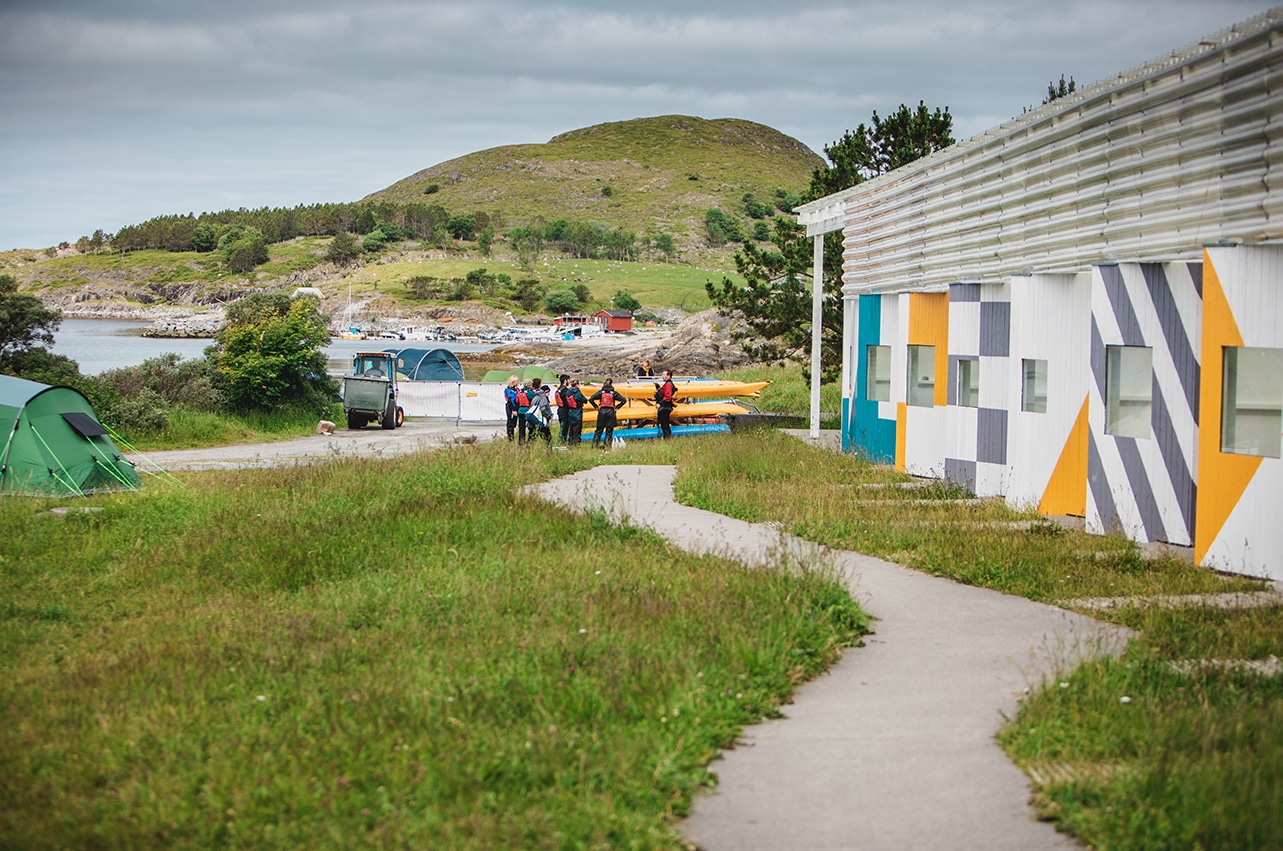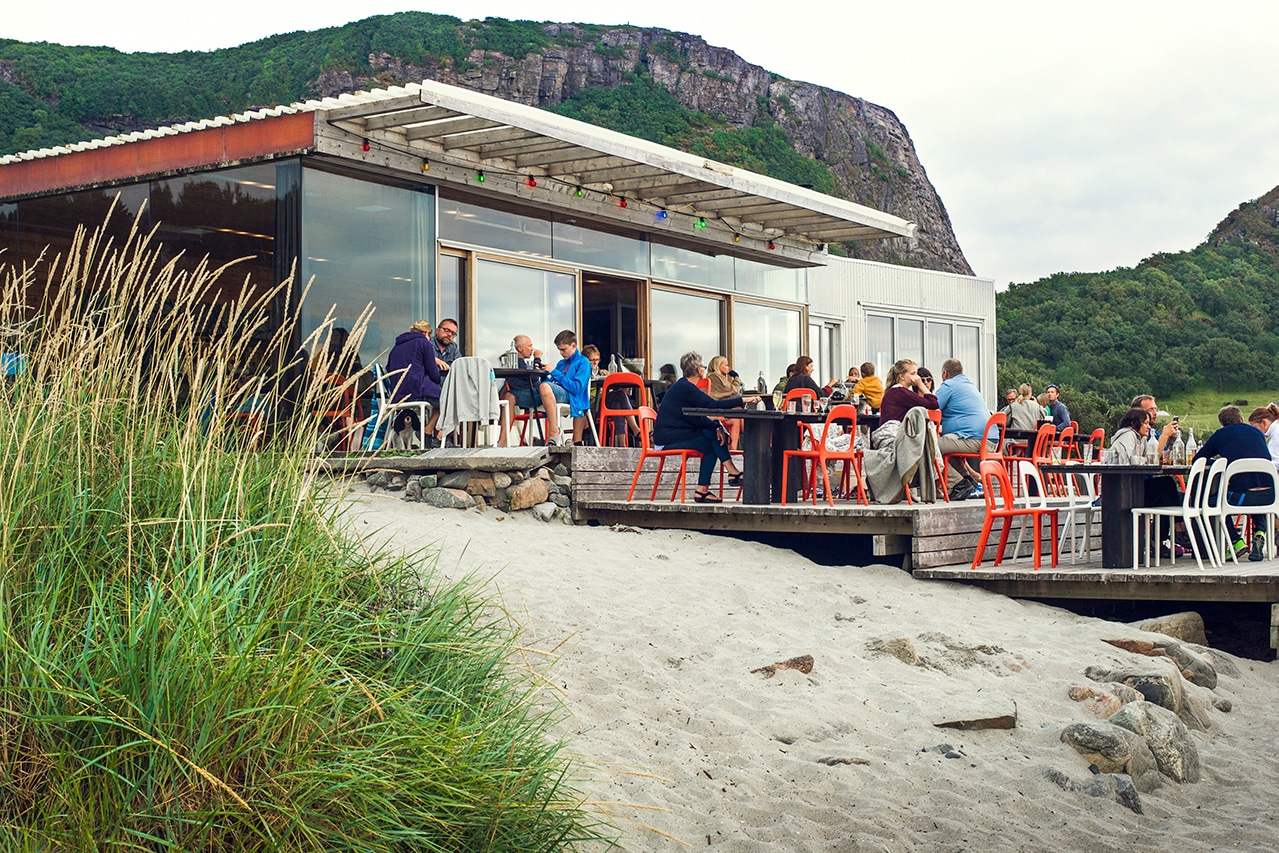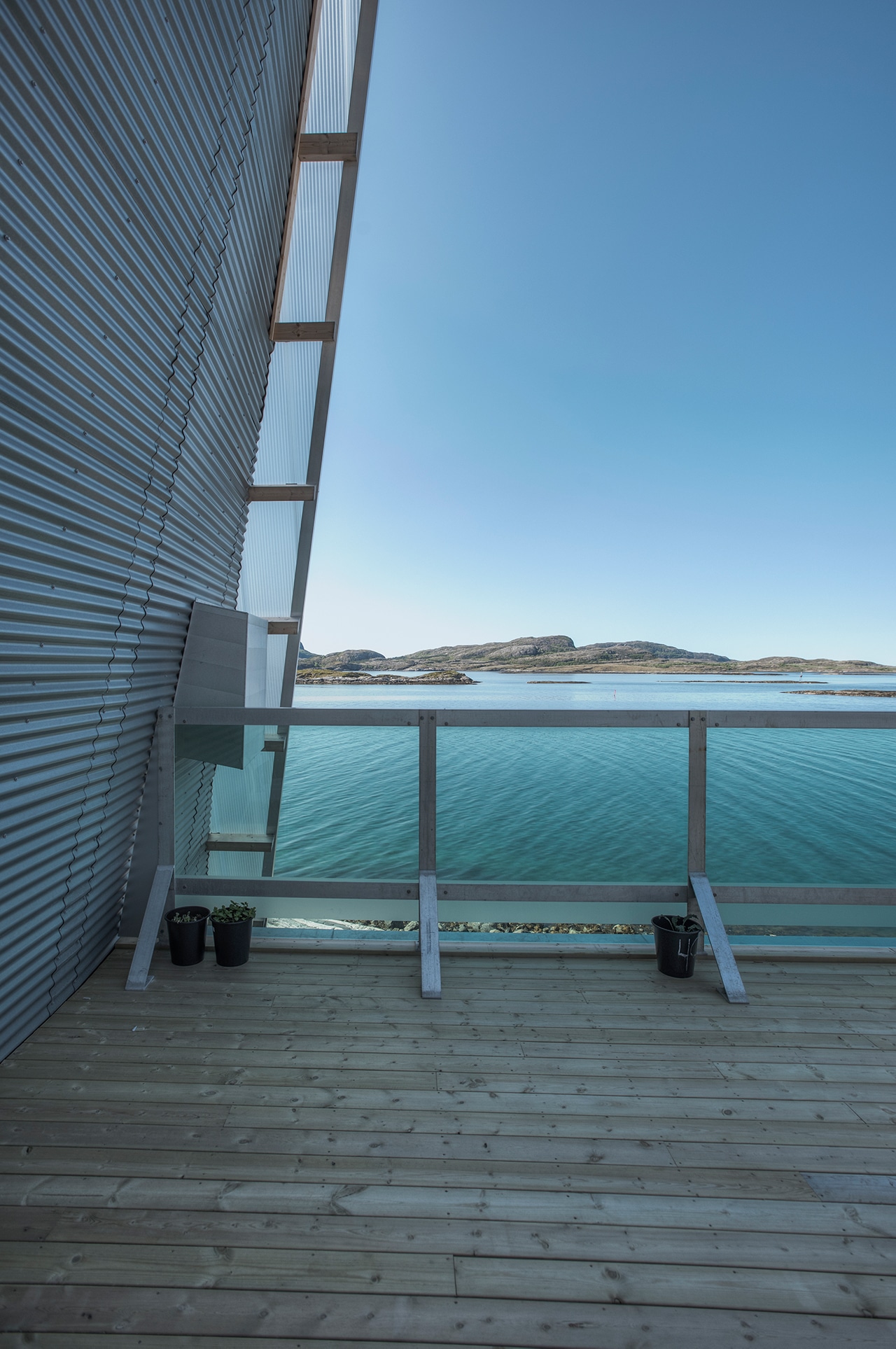
The multi-purpose Bygdebox, designed by Pir II Architects, repurposes materials from a nearby ship graveyard, glass from a demolished government building, and facade panels from an old bank. [Photo: Gerhardsen Karlsen]
On a small Norwegian island, family, friends, and neighbors are building a community worth trekking to.
Less than 400 residents live on the island of Stokkøya—and perhaps just as many sheep. To get there, you must take a 25-minute ferry from Trondheim, the third most populous city in Norway, then travel 90 minutes by car or bus. Once you’ve arrived, you’ll find ample room to kayak, lie on the beach, camp, or hike. While some would want to keep this oasis on the Norwegian Sea to themselves, people here are planning for the future—and inviting others to join them.
“We want to have people living in the countryside. It’s important,” says Ingrid Langklopp, the business developer at Stokkøya Sjøsenter, the growing island resort that includes 30 cottages tucked into the seaside forest, a small hotel, restaurant, bar, art and music spaces, and more. “We have the resources,” she says. “You have to have great brains to take care of these resources. And we have to think about what will attract these great brains.”
The resort began when Roar Svenning, who grew up on the island, returned home after years of working all over the world. When he moved away as a young man, his life revolved more around art and punk music. But his heart was never far from Stokkøya and, eventually it seemed, he’d be able to combine his loves. He asked himself what he’d need to live and thrive on his home island. Was it as simple as a beach bar?

Bygdekanten, a new housing development with a contemporary architectural look on the water.[Rendering: Pir II Architects]
Together with his wife, Torild, his wife’s sister (Ingrid), and Ingrid’s husband (a furniture-maker who also lives and works on the island), Svenning began to bring his dream for a creative rural community to life in the early 2000s. The group focused on nature, architecture, food, and experience. “We try our best to adjust our buildings to the nature, not the opposite. Less dynamite and more nature-adaptive architecture,” Svenning says.
He says rural areas anywhere could benefit from the Stokkøya approach, with careful planning to increase the quality of life and attract smart, talented people. Svenning says it’s not hard to imagine that a growing world population will need more food and a more sustainable food production process; the farm needs farmers. By 2050 the world’s population is expected to increase by 34%, according to the Food and Agriculture Organization of the United Nations. Nearly 70% of the world’s population is expected to live in cities by 2050. “Some qualified people need to stay in the countryside where food is produced,” he says. “The countryside will get its renaissance, but it’s better if it happens well planned than to wait until the shit hits the fan.”

Gatherers at the Stokkøya Festival. [Photo: Gerhardsen Karlsen]
Sustainable Development
First came the cottages, which started going up in 2002 in an effort to make money and further invest in development while attracting good visitors and neighbors. The 30th was complete in 2018. “Then, in 2005 we built the Beach Bar as a very important means for social life, a place to eat and drink, and a source for income and jobs,” Svenning says.
Today on the coast you’ll also find a multi-purpose building, Bygdebox, with a large conference room, coworking space, bakery, wood workshop, meeting rooms, and more. The area is now the centerpiece of Stokkøya Festival, a music and arts festival that launched in 2018 (pg. 50). It’s all part of the Bygda 2.0 development, which began in 2010.
Designed by Pir II Architects (an award-winning Trondheim firm known for environmental architecture), Bygdebox is one of many examples of how the Stokkøya team is building creatively. All projects in and around the resort implement reused materials as much as possible, Langklopp says. For Bygdebox, the large triangular building near the waterfront, crews used leftover materials from other projects and a nearby ship graveyard. The multi-purpose area used green glass from a demolished government building, facade panels from an old local bank, and leftover doors and windows from other projects. Back at the Stokkøya hotel (less than a 10-minute walk from Bygda 2.0), repurposing was also key when it was built in 2008. “We used a lot of recycled materials to build furniture, and we brought in students to build furniture,” Langklopp says. “We used old sails to make curtains; we picked up things from the ship graveyard to put on the wall.”
Langklopp says sustainable architecture was always part of the resort’s plan, emphasizing that buildings can work with, not against, nature. “We want to have great architecture but without spending lots of money,” she says. “To think and build like this can be a bit more time-consuming in the planning phase, but when doing it, we save the environment, we lower our investments, and it also gives our projects and buildings unique character.”

Pir II AS, an award-winning, environmentally conscious architecture firm, designed the resort’s Strandbaren restaurant, hotel, cottages, and Bygdebox, among other buildings.
Being, and Building, Good Neighbors
In early 2019, the first four of eight townhouses began being built on the waterfront. These are being developed in cooperation with local industry actors and the local municipality, and they’ll be available for rent, permanent residence, and artists in residence. The houses are built according to Norwegian Husbanken (the state housing bank) standards, so they must meet passive house standards for favorable loan terms. Called Bygdekanten, meaning “on the edge of the village,” the new housing project aims to show off contemporary architecture in a powerful seaside setting for people who want to live in nature without sacrificing urban amenities like a nice cocktail or live music.
The demand for these houses is clearly there. Three of the first four have already sold, and Langklopp receives emails every day from people all over the world who are interested in the next four in phase two. She says the buyers and renters are diverse, too, from a man in his 60s to a young, local couple. “That is what we aim for. It’s not for a homogenous group. It should be very diverse.”
The evolution of the community over 10-plus years has been inspiring. When Svenning was a kid, twice as many people lived on the island, and he’s happy to see the population back on the incline. “Seeing good people moving out here is the most satisfying thing,” he says. “That property keeps a good price is also a good indicator that the area is healthy.”

[Photo: Courtesy of Pasi Aalto]
BUILDING A GREEN MUSIC FESTIVAL
On a Friday in July, volunteers scurry to and from the festival stage, campsites, cabins, and boat dock. They’re dressed in red caps in tribute to Jacques Cousteau, and their excitement is palpable. Roughly 1,500 people have come out to the island for Stokkøya Festival, a weekend of music and activities like kayaking, beach yoga, and sustainability workshops. Wenche Bendixvold-Ryjord has managed festivals before, but like all major events, she knew Stokkøya would come with its own set of challenges. “We were especially concerned about how the land, nature, and the environments would handle so many people gathering at a very fragile place,” she says.
From the start, the staff set out to make a plastic-free festival—no Solo cups here. “We were pretty excited about running a sustainable festival, reducing single use plastic by 80% the first year.” The crew also led a composting project, showing festival-goers where their food scraps really went. Water filling stations were plentiful, significantly reducing water bottles. Food at the fest was hyperlocal, too. “The audience embraced the concept and almost made it into a sport cleaning up after themselves,” Bendixvold-Ryjord says, adding that the amount of non-recycled waste totaled less than 1 kilogram per attendee. She says it proves the festival lived by its motto to reduce, reuse, and recycle, and the audience did, too. “People are getting it, they are helping us, and as a result we leave smaller footprints.”
